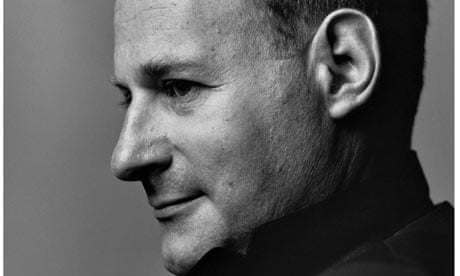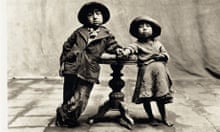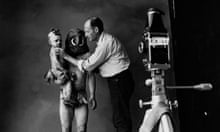Irving Penn, who has died aged 92, was one of the great photographers of the 20th century. His fashion pictures appeared in Vogue from the 1940s onwards, but he became known, too, for his portraits of writers, artists, celebrities, children and tradesmen, as well as his studies of tribesmen, nudes and still-lifes, which found beauty in decaying fruit or cigarette ends. He once claimed that "photographing a cake can be art".
One of Penn's preferred descriptions for his photographs was "beatitudes". But rather than decorative Baroque angels, Penn's "religion" was defined by the utmost serenity and a deceptive simplicity, at the meeting point where form becomes style. This style, which showed a firm maturity from his early career, remained true whether applied to fashion or flowers, in colour or in black and white, in photographs taken in the US or Africa.
In the encyclopedia Contemporary Photographers (1982), Penn's work is represented by Ospedale, taken in 1980. It shows an austere arrangement of a cracked jug surmounted by a toothed skull and encircled by a rough crucifix, a scattering of ashes, and an unstoppered bottle of either medicine or poison. Such a composition painted in the middle ages might have appeared with a moralistic title, like Sic transit gloria mundi. Penn's picture, under the simple title "hospital", can be read as a very different parable of contemporary attitudes to life.
Not that the world's glories passed him by, and he was ever a curious blend of the aesthete with the ascetic. He was born in Plainfield, New Jersey, the son of Harry, a watchmaker, and Sonia, a nurse. His younger brother, Arthur, became a well-known film director. From 1934 until 1938, Penn studied design at the Philadelphia Museum School of Industrial Art under the legendary designer Alexey Brodovitch, who would travel to Philadelphia each week from New York, where he worked for Harper's Bazaar.
After working unpaid under Brodovitch at Bazaar, Penn spent a brief – but formative – period redesigning the advertising strategy for the Fifth Avenue department store Saks. He also began photographing Manhattan street scenes. He then spent a year painting in Mexico, which he later claimed gave him much of his insight into devising the starkness of lighting and simplicity of form that became two of his signal characteristics.
On his return from Mexico, Penn was introduced through Brodovitch to Alexander Liberman, art director of Vogue, and became his assistant. Penn's first photographic work for Vogue, a still life of glove, belt and purse, was published as the cover of the October 1943 issue. Over his long years with Condé Nast, publishers of Vogue, his photographs would appear on more than 150 covers.
Some of his first incursions into professional photography were with the American Field Service during the second world war, assisting the British army in Italy and India in 1944-45. He returned to Vogue as staff photographer in 1946.
In 1950 he married Lisa Fonssagrives, a leading fashion model, with whom he continued to work. Yet he began to succeed in bending the rarefied ambience in which he moved at Vogue to admit a form of photography (including a black-and-white cover shot) that the magazine had never previously contemplated. He began, even, to admit his increasing restlessness with fashion and a growing interest in portraiture, influenced by the socially conscious work of Walker Evans and the meticulous documentation of domestic detail by the early French photographer Eugène Atget.
Penn had the gift of taking inspiration from whatever source of influence he chose and then, avoiding the derivative, honing it down to its essence. Hence the much-vaunted sparseness of his work. Hence also the apparent anachronism of his captions. Together with the Mexican photographer Alvarez Bravo, Penn believed captions to be an integral part of the picture. A fleeting 1951 fashion shot of Lisa in a ballgown, there only in silhouette, was captioned Woman with a Handkerchief, one element vividly catching the light. In The Girl with Tobacco On Her Tongue (in the same year), a tobacco curl is scraped from the poking tongue by a pointedly long nail, sidelining the fashion accessories of hat, earrings and halterneck.
Penn's eye for what verges on the mysterious and sinister was employed to perfection in his famous 1974 series Worlds in a Small Room, its title referring to the portable studio he took with him while travelling through Asia to Australia. Thanks to this, he could recreate his preferred blank background and shoot the "mud men" of Asaro or the peasants of Peru in the same neutralised setting as his fashion shots. His eye for often surprising detail, combined with the extreme formality of composition, and the contrast of chiaroscuro illumination, lends a New-York-meets-Rembrandt incongruity to all of Penn's work, regardless of its subject matter. By the 1960s, this paring down had led to a sequence of nudes as experimental in their own way as Bill Brandt's, but with meticulous exactitude replacing Brandt's contrived distortions. They were shown many years later in Earthly Bodies at the Marlborough Gallery in 1980.
From the 1980s, Penn increasingly moved over to colour portraits, preferring flowers and still lifes to people. The paradox whereby even the most perfect bloom is also in a state of decay intrigued him, as an awareness of mortality impinged. Such themes allowed him to refine his belief in the links between painting and photography, the aesthetic principles by which he could impose order on nature and so the world.
Maurice Goudeket, husband of the French writer Colette, expressed Penn's capacity to shock with the familiar, describing his visit to photograph the novelist in 1951 at the approach of her 80th birthday: "He took a stupefying photograph. It discloses all that Colette wished to conceal and of which she was no doubt ignorant about herself. In reality it was the hidden person we all have in us. A great portraitist – they are very few – is a sort of sorcerer who sees beyond resemblance."
Penn's manner of working was highly unusual. According to Cecil Beaton, writing in 1975: "Penn makes everything extremely hard for himself. He employs no gadgets, no special props, nothing but the simplest lighting – probably a one-source light coming from the side of the sitter's head." Too true. In Penn's 1950 portrait of Beaton, one half of his face is in deep shadow while the other is highlighted, a perfect foil for the sweep of his black cape and the soft folds of his white cravat.
It was a technique that proved equally well suited to Penn's portrait of a Coal Man (1950), whose leather helmet, with its long back-flap (against which he would carry his hod of coal) gleams black against the white of one shirtsleeve, though the shoulder is striped with dust. Both men are shot against the same studio backdrop Penn used regularly for his fashion shoots in the 1950s.
Whatever the source of Penn's inspiration in Latin America, the fascination with abstractions about what was hidden and what revealed, or with the use of light and contrast over subject matter came, as Beaton went on to conclude, from his being "dans le vrai ... it is the burning intensity of Penn's own being that puts the value into his pictures".
In 1984 a retrospective was organised by John Szarkowski at the Museum of Modern Art (MoMA) in New York and from 1987 Penn's work was exhibited regularly at the Pace-MacGill Gallery in New York. In 1996 Penn presented archives and prints to the Chicago Art Institute. His work is held in collections including the Metropolitan Museum and MoMA, the Smithsonian Institution in Washington, the Galleria Civica d'Arte Moderna in Turin, the Stedelijk Museum, Amsterdam, and the Victoria and Albert Museum in London.
Fonssagrives died in 1992. Penn is survived by their son Tom, a step-daughter, Mia, eight grandchildren, and his brother, Arthur.
Veronica Horwell writes: Alexander Liberman, who, as art director of Vogue in 1943, gave Penn a job, remembered that the young man "wore sneakers and no tie". Liberman thought him direct, clear and possessed of "American instincts that made him go for the essentials". What Liberman understood was that Penn's view of the world, and soon of fashion, was the equivalent of the hard prose of American literature, a technique of artful sparseness. Penn's postwar return to Vogue as a staff photographer was perfectly timed, as fashion turned sculptural even before Dior's 1947 collection made an extreme outline and a moulded shape the bases of the mode for 20 years.
The details – hats, gloves, amplified sleeves and collars – were like wearable maquettes for bronzes, and that's how Penn shot them, so solid they could have been put on a plinth. The overall ensembles were meant to be seen as silhouettes, and that's how Penn pictured them, removing all superfluities except the poses of his favourite models, often gesturing with cigarettes, before a textured back wall. His 1947 portrait of 12 models allowed the tatty floor to show between their gowns. Sent to Paris in 1950 to photograph the collections, he borrowed a studio and shot by daylight with an old theatre curtain in lieu of the wall.
Not all the drama in Penn's images was provided by the clothes, although his great 1950 Vogue cover of amused eyes and mouth beneath a hat veil and atop an insane bow is a romantic comedy in itself. He liked to project the bold characters of his favourite models (including his wife) and tell a story without a location and with few props. Look at his 1949 conversation piece, two models (one wearing purposeful glasses) slouched at a table, reading, smoking, drinking coffee, their bags dumped on the floor or over the chairback. It's a proposal about female independence of behaviour well over a decade before it became fact. Even his wackier images, such as Jean Patchett sweetly disordered in a crumpled bed, suggest women with an inner life, and possibly a full-time job.
He was enthusiastic about the assertive physical vocabulary women began to use by the early 1960s. The model Wilhelmina folds herself firmly into a Penn cover space, her boot balanced on the bottom of the frame. But he was less comfortable with the later 1960s sensation of fast movement in fashion photography, and with the formlessness of the garb. He arranged hippies against the same wall as for his dozen models in 1947, but their messiness and droopiness confounded his Shaker purity.
Penn went on responding to couture with line and mass, and Issey Miyake wrote of the pictures Penn took in the 1980s of his designs, with their paper sculpture quality: "The clothes have been given a voice of their own ... Here were my clothes, but shown in such a way that they appeared totally new to me." He finally stripped away even the wall as not minimal enough, in 1988 producing a sequence with no background at all. Christy Turlington simply existed, relaxed, on the bare pages.
Penn also pioneered the beauty image as Vogue introduced substantial sections given over to cosmetics and skincare. He kept to the details, abstracted into a calm American surrealism (among his heroes was Giorgio de Chirico). His cool visions of glass bottles for advertisements for Estée Lauder's medicalised Clinique line still dominate the business nearly 40 years later.



